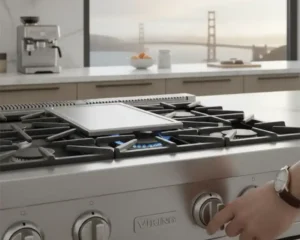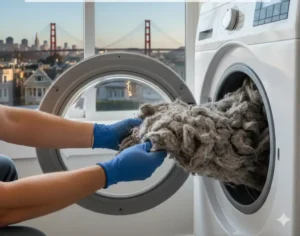Electric Dryer Not Heating? Troubleshooting Guide for Your Electric Dryer
Is your electric dryer not heating? You’re not alone. A dryer that runs but doesn’t produce heat is one of the most common appliance issues homeowners face. It’s frustrating, especially when you have a pile of laundry waiting to be dried. The good news is that many dryer heating problems can be diagnosed and fixed without calling a professional. In this guide, we’ll walk you through the common causes, step-by-step troubleshooting tips, and solutions to get your dryer working again.
Common Causes of an Electric Dryer Not Heating
Before diving into repairs, it’s essential to understand why your electric dryer might not be heating. Here are the most common reasons:
- Thermal Fuse Blown
The thermal fuse is a safety device that prevents your dryer from overheating. If it blows, the dryer may run but won’t heat. This problem often happens due to restricted airflow (e.g., a clogged lint filter or vent).
- Faulty Heating Element
The heating element is responsible for generating heat. Over time, it can wear out or break, causing the dryer to stop heating.
- Defective Thermostat
Dryers have multiple thermostats that regulate temperature. If one fails, it can interrupt the heating cycle.
- Broken Thermal Cutoff
Like the thermal fuse, the cutoff shuts off the heating element if the dryer gets too hot. If it’s faulty, the dryer won’t heat.
- Power Supply Issues
Sometimes, the problem isn’t with the dryer but the power supply. A tripped breaker or faulty outlet can prevent the dryer from heating.
- Clogged Vent or Duct
As a safety measure, a blocked vent or duct can restrict airflow, causing the dryer to overheat and shut off the heating element.
How to Troubleshoot and Fix an Electric Dryer Not Heating
Now that you know the common causes, let’s investigate the troubleshooting process. Follow these steps to diagnose and fix the problem:
Step 1: Check the Power Supply
- Plug in the dryer and check that the circuit breaker hasn’t tripped.
- Test the outlet with another appliance to confirm it’s working.
- If the outlet is faulty, call an electrician to fix it.
Safety Precaution:
- Unplug the dryer and turn off the breaker before inspecting the power supply.
- Use a voltage tester to ensure no live current.
Step 2: Inspect the Thermal Fuse
- Locate the thermal fuse (consult your dryer’s manual for its location).
- Use a multimeter to test for continuity. If there’s no continuity, the fuse is blown and needs replacement.
- Replace the fuse and clean the lint filter and vent to prevent future issues.
Safety Precautions:
- Unplug the dryer and allow it to cool.
- Wear insulated gloves when handling the thermal fuse.
Step 3: Test the Heating Element
- Unplug the dryer and locate the heating element (usually at the back or bottom of the dryer).
- Check for visible damage, such as breaks or burns.
- Use a multimeter to test for continuity. If the heating element is faulty, replace it.
Safety precautions:
- Unplug the dryer.
- Ground yourself to avoid static discharge.
- Scrutinize the heating element for damage.
Step 4: Examine the Thermostats
- Dryers have multiple thermostats, including the high-limit thermostat and cycling thermostat.
- Test each thermostat with a multimeter. If any fail the continuity test, replace them.
Safety precautions:
- Unplug the dryer.
- Label wires before removal.
- Use a multimeter safely to avoid electric shock.
Step 5: Check the Thermal Cutoff
- The thermal cutoff is another safety device that can fail if the dryer overheats.
- Test it with a multimeter and replace it if necessary.
Safety precautions:
- Unplug the dryer.
- Handle the thermal cutoff gently
- Avoid short circuits when testing with a multimeter.
Step 6: Clean the Vent and Duct
- A clogged vent or duct is a common cause of dryer heating problems.
- Disconnect the vent hose and clean out any lint or debris.
- Consider hiring a professional to clean the ductwork if it’s heavily clogged.
Safety precautions:
- Unplug the dryer.
- Wear gloves and a dust mask.
- Watch for sharp edges while cleaning the vent hose.
Preventative Maintenance Tips
To avoid future issues with your electric dryer not heating, follow these maintenance tips:
- Clean the lint filter after every load.
- Inspect and clean the vent and ductwork at least once a year.
- Avoid overloading the dryer, as this can strain the heating element.
- Regularly check the dryer’s components for signs of wear and tear.
When to Call a Mechanic
While you can resolve many electric dryer heating issues with a bit of DIY effort, there are times when calling a professional is the best course of action. Seeking help at the right time can save you time, prevent further damage, and ensure your dryer gets repaired safely and correctly. Here are some scenarios where it’s wise to call a mechanic:
1. You’ve Tried Every Step, and the Dryer Still Won’t Heat
If you’ve gone through all the troubleshooting steps—checked the thermal fuse, tested the heating element, inspected the thermostats, and cleaned the vent—but your dryer still isn’t heating, it’s time to call a professional. A more complex issue may be at play, such as a problem with the control board or wiring, which requires specialized knowledge and tools to fix.
2. You’re Uncomfortable Working with Electrical Components
Repairing an electric dryer requires working with high-voltage components, which are dangerous if you lack experience. If you’re unsure about testing or replacing parts like the heating element or thermal fuse, it’s better to leave it to a qualified technician. Your safety is more important than saving a few dollars on repairs.
3. The Dryer Shows Signs of Electrical Issues
If you notice burning smells, sparks, or unusual noises from your dryer, stop using it immediately and call a mechanic. These could be signs of serious electrical problems that pose a fire hazard. A professional can diagnose and fix the issue safely.
4. You Don’t Have the Right Tools
Some dryer repairs require specialized tools, such as a multimeter for testing components or specific screwdrivers for accessing internal parts. If you don’t have these tools or aren’t sure how to use them, a mechanic will have the tools needed to do the job efficiently.
5. The Dryer Is Still Under Warranty
Attempting DIY repairs could void the coverage if your dryer is under warranty. In this case, it’s best to contact the manufacturer or an authorized repair service to handle the issue. A professional can repair it according to warranty guidelines.
6. You’re Dealing with a Gas Dryer
If you have a gas dryer that’s not heating, the problem could be related to the gas supply or ignition system. Gas appliances require specialized knowledge to repair safely, so it’s always best to call a professional for these issues.
Final Thoughts
A dryer that’s not heating can be a significant inconvenience, but in most cases, it’s a problem you can fix yourself. By understanding the common causes and following the troubleshooting steps outlined above, you can save time and money on repairs.
If you’ve tried every step and your dryer still isn’t heating, it may be time to call a professional. However, a little DIY effort can get your dryer back in working order for most issues like a blown thermal fuse, faulty heating element, or clogged vent.
Frequently Asked Questions (FAQs)
1. Why is my electric dryer running but not heating?
Your dryer may run but not heat due to a blown thermal fuse, faulty heating element, defective thermostat, or clogged vent. These issues can interrupt the heating cycle while allowing the drum to spin.
2. How do I know if my dryer’s thermal fuse is blown?
To check if the thermal fuse is blown, unplug the dryer, locate the fuse (usually near the heating element), and use a multimeter to test for continuity. If there’s no continuity, the fuse is blown and needs replacement.
3. Can I replace the heating element myself?
Yes, you can replace the heating element yourself if you’re comfortable working with electrical components. Unplug the dryer, locate the heating element, and follow the manufacturer’s instructions for replacement.
4. How much does it cost to fix a dryer that’s not heating?
The cost depends on the issue. Replacing a thermal fuse or heating element can cost between 20and20and50 for parts, while professional repairs may range from 100to100to300, including labor.
5. What causes a dryer to stop heating after a power outage?
A power outage can trip the circuit breaker or blow the thermal fuse, causing the dryer to stop heating. Check the breaker and test the thermal fuse to diagnose the issue.
6. How often should I clean my dryer vent?
Clean your dryer vent at least once a year to prevent lint buildup, which can restrict airflow and cause the dryer to overheat or stop heating.
7. Is it worth repairing an electric dryer that’s not heating?
If your dryer is relatively new and the repair cost is low (e.g., replacing a thermal fuse or heating element), it’s worth repairing. However, if the dryer is old and repair costs are high, consider replacing it.
8. Why does my dryer overheat and stop heating?
Overheating is often caused by restricted airflow due to a clogged vent or lint filter. The thermal fuse or cutoff may blow as a safety measure, causing the dryer to stop heating.
9. Can a clogged vent cause my dryer to stop heating?
Yes, a clogged vent restricts airflow, causing the dryer to overheat and triggering the thermal fuse or cutoff to shut off the heating element.
10. When should I call a professional for dryer repairs?
Call a professional if you’ve tried all troubleshooting steps, are uncomfortable working with electrical components, or notice signs of electrical issues like burning smells or sparks.






